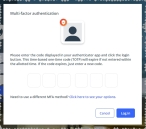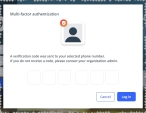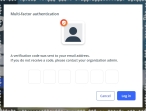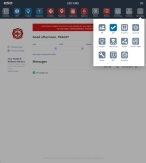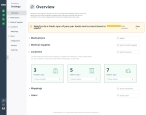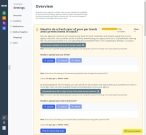Synchronize the Inventory module with items currently in stock
If your agency adds new products, or if you perform an inventory of items in stock and find you have more or less of specific items than expected, you can update the lot numbers, expiration dates, and quantities of items in inventory right now, at each location and sublocation across your agency, by uploading a spreadsheet with the current data. The Inventory module then synchronizes the quantities of items in the ESO Suite database with the data from the spreadsheet.
-
 If you have not done so already) Access the Inventory module in the ESO Suite.
If you have not done so already) Access the Inventory module in the ESO Suite.
-
Do one of the following.
-
(If you are already working in the ESO Suite) Click the Home icon in the upper left corner of the screen.
-
 (If you have not yet logged in) Log in to the ESO Suite.
(If you have not yet logged in) Log in to the ESO Suite.
-
In a web browser, go to https://www.esosuite.net/EsoSuite.
The ESO Suite login screen appears.
-
Enter your user name, password, and agency name, then click Let's Go.
If MFA is enabled, the Multi-factor authentication dialog box appears, displaying one or more methods you can use to verify your login credentials. The number of methods that appear in the dialog box depends on what MFA methods your ESO Suite administrators enabled in the Admin module.
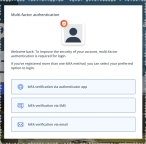
Click graphics
to open them.Information on enabling MFA and specific MFA methods is available in the Admin module online help, in Configure multiple-factor authentication.
Note: If your ESO Suite administrators have disabled MFA ("opted-out"), this dialog does not appear.
-
(If the Multi-factor authentication dialog box appears) Depending on which buttons appear in the dialog box, verify your login in one of the following ways.
 With an authenticator application.
With an authenticator application.
-
Click MFA verification via authenticator app.
The dialog box updates with boxes for entering the numbers of the authentication code, and the ESO Suite sends an authentication code to the authenticator application installed on your device.
-
Open your authenticator application and note the authentication code currently displayed.
-
Enter the authentication code displayed in the authenticator application.
-
Click Log In.
 With a text message (SMS).
With a text message (SMS).
-
Click MFA verification via SMS.
The dialog box updates with boxes for entering the numbers of the authentication code, and the ESO Suite sends an authentication code to the phone number recorded in your PM records and identified with MFA codes.
-
Enter the authentication code sent to your MFA-registered phone number.
-
Click Log In.
 With an email message.
With an email message.
-
Click MFA verification via email.
The dialog box updates with boxes for entering the numbers of the authentication code, and the ESO Suite sends an authentication code to your agency or department email address, recorded in your PM records.
-
Enter the authentication code sent to your agency or department email address.
-
Click Log In.
-
-
The ESO Suite landing screen appears.
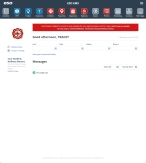
Click graphics
to open them.Note: If MFA is enabled, you can access and manage your MFA options through the PM module, on the Settings > Account page, as described in Manage a user account. If your agency or department has enabled MFA but has not purchased the full-featured version of the PM module, you can access your own MFA settings by clicking Change my Multi-Factor Authentication settings on the landing screen, then using the Settings > Account page that appears. If your agency has not enabled MFA, the Change my Multi-Factor Authentication settings link does not appear on the landing screen.
-
-
On the top side of the home screen, click Inventory.

The Inventory module opens, displaying the Action now page.
Click graphics
to open them.
-
-
In the left pane, near the bottom, click the Settings icon.

The Settings screen appears, displaying the Overview pane on the right. This page provides a summary of the information in the Settings pages. The Overview pane groups the information into drop-downs named Medications, Medical Supplies, Locations, Mappings, and Users. By default, these drop-downs are expanded; however, you can collapse and expand them as needed to view only the information you want.
These drop-downs contain one or more categories within them, to help further organize the information.
Example: The Locations drop-down contains the Stations, Hospitals, and Vehicles categories, to represent the different types of locations your agency may stock with inventory.
The numbers on the category summaries indicate how many items that your agency currently has enabled in the item catalog, in each category.
Example: If the numbers on the card are 44/49, that indicates that your agency has enabled 44 of the 49 available items in the catalog, and tracks the inventory records for those 44 items.
-
At the top of the Overview page, on the right side of the Need to do a fresh sync of your par levels and current items in stock? section, click Open.
The section expands to display buttons and fields related to updating the par levels for the items in your agency's item catalog, and for updating the current number and quantity of items currently in its inventory.
-
 Download the blank inventory spreadsheet.
Download the blank inventory spreadsheet.
-
In the bottom half of this section, click Download items list to align all your item stock across locations.
The
Inventory_Levels.xlsxspreadsheet downloads to your default download location, or prompts you for a location, depending on your browser settings. -
Navigate to the download location and open the spreadsheet.
At the bottom of the spreadsheet is a sheet tab for each of your agency's locations, with the first location tab selected by default.
In column A, the spreadsheet lists every item in your agency's item catalog, and the rest of the columns let you specify where items are stored, how much you have on hand, and whether or not you need to track that item by lot number and expiration date.
-
-
 Populate the spreadsheet with current inventory data.
Populate the spreadsheet with current inventory data.
Note: You do not have to fill every row on every location tab in the spreadsheet with data. You only need to add inventory data to the location tabs and item rows that need updates.
When you upload the spreadsheet later, items in the Inventory module that correspond to blank rows in the spreadsheet do not change in the ESO Suite database.
-
In the yellow Protected View banner across the top of the spreadsheet, click Enable Editing.
-
In the row for the first item in your agency's item catalog, in the Sublocation column, click the cell and choose the sublocation the item is stored in.
-
Depending on whether or not your agency tracks the item's lot number and expiration date, do one of the following.
 The agency tracks the item's lot numbers and expiration dates
The agency tracks the item's lot numbers and expiration dates
Because an item can come from a supplier in lots or batches, and each lot or batch can have its own expiration date, the spreadsheet contains groups of columns under the heading Tracked items details. Each group of columns is identified as Lot 1, Lot 2, and Lot 3, and contain columns for specifying the lot/batch number, the number or amount in inventory of that specific lot/batch number, and the expiration date for that lot/batch.
-
In the same row, in the Tracked items details group of columns, in the Lot 1 sub-group of columns, click the cells in the Quantity, Lot #, and Expiry date columns, and enter the necessary information for that lot or batch.
-
(If you have more than one lot or batch of that item in inventory) In the same row, in the Lot 2 and Lot 3 sub-groups of columns, enter the necessary information for the additional lots or batches.
-
-
Repeat the previous steps b–c for every item row in that location's page in the spreadsheet.
-
Save your changes in the spreadsheet.
-
At the bottom of the spreadsheet, click the sheet tab for the next of your agency's locations.
The unfilled inventory page for that location appears.
-
Repeat steps b–f until you have filled all the location sheet tabs in the spreadsheet with the updates to your current inventory.
-
-
 Upload the inventory spreadsheet.
Upload the inventory spreadsheet.
-
In the Inventory module, at the top of the Overview page, under Ready to upload your item stock levels?, click Choose.
-
Use the file browser that appears to navigate to and open the spreadsheet you populated with inventory levels for your agency.
The name of your file appears under Ready to upload your item stock levels?, and the Upload and Cancel buttons activate.
-
Click Upload.
A progress bar appears across the bottom of the section, then a success message appears in the upper right corner of the page when the Inventory module finishes uploading the spreadsheet to the ESO Suite database.
-
-
 Verify that the item numbers and quantities you updated in the spreadsheet appear in the Inventory module as expected.
Verify that the item numbers and quantities you updated in the spreadsheet appear in the Inventory module as expected.
-
In the upper left corner of the screen, click the Inventory list icon.

The Inventory list page appears, displaying a listing of every item in your agency's item catalog at the location selected in the upper right corner of the page, from the Viewing menu. The page contains information about the number or quantity of each item currently in the inventory at that location, the min and max par levels for that locations, and so forth.
-
In the inventory list, find the items you updated in the spreadsheet, and compare the current values in the Inventory module to the values you specified in the spreadsheet.
-

